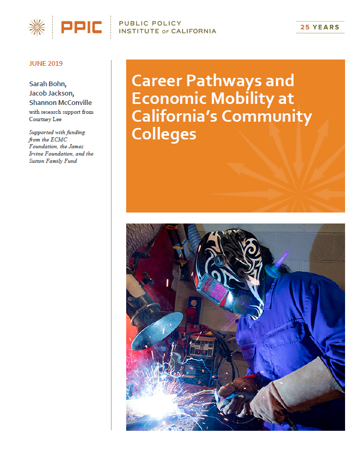Career Pathways and Economic Mobility at California’s Community Colleges
June 27, 2019
By Sarah Bohn, Jacob Jackson and Shannon Mcconville, Public Policy Institute of California
Summary
Career education programs in California’s community colleges are a critical component of public higher education in the state. Also known as career technical or vocational programs, career education trains individuals for middle-skill jobs that require more than a high school diploma but less than a four-year degree. These jobs make up a third of California’s labor market today and are projected to make up a similar share in the future.
Career education credentials, such as associate degrees and certificates, typically take less time to complete and offer lower economic payoffs than bachelor’s degrees. But career education can also connect students to career pathways that offer opportunities for advancement—particularly important for workers with lower levels of education and those in need of retraining. In this report, we examine whether career education pathways improve students’ long-term earnings and the factors associated with wage gains. Our analysis uses detailed student records that reflect enrollment and completion in career education programs as well as earnings before and after students finish their credentials. We find:
- Career education credentials typically provide economic benefits. Overall, credential holders saw a 20 percent increase in earnings. In addition, the majority of students begin earning middle-income wages within one year of completing a career education program. What constitutes middle income varies across the state, from at least $23,400 in annual earnings for a single person in the Central Valley to $32,800 in the San Jose region.
- Wage gains vary considerably by program area and credential length. Returns to career education credentials ranged from virtually zero in some business and IT programs to more than 100 percent increases in earnings for associate degrees in health. Students who received only one short-term certificate saw lower wage increases (8%) than those receiving a single long-term certificate (21%) or associate degree (32%).
- Stackable pathways are linked to increased earnings, but they take longer.Students who start with certificates but then complete additional credentials in the same field—what we refer to as “stacking”—typically catch up in earnings to students who only complete a single, high-return credential. However, it takes about two years for the majority of students who begin with a short-term certificate and then stack additional credentials to earn middle-income wages, compared to less than half a year for students who initially earn an associate degree.
- Earnings trajectories vary across racial/ethnic groups. These differences are largely related to the programs in which students earn their award. For example, Latino and African American students are more likely to earn credentials in early childhood education—which typically yield low returns—while fewer enroll in higher-return programs like health. There are also earnings gaps between students of different racial/ethnic backgrounds for the same credentials, though these differences tend to be smaller.
- Not all career education programs align with well-paying jobs. Some career education programs prepare students for jobs in protective services, health care technical fields, and engineering technical fields, which offer current workers solidly middle-income earnings. However, other programs may lead to middle-skill jobs in low-paying industries, such as health care support and personal care.
- Regional factors affect future opportunities for middle-skill jobs. In the far north, the Sacramento area, the Central Valley, and the Inland Empire, at least a third of future jobs will likely require some college training but not a bachelor’s degree. In contrast, in the Bay Area and San Jose regions, no more than a quarter of future jobs are projected to need middle-skill workers.
To further boost economic outcomes for career education students, California’s community colleges should continue their efforts to enhance student advising and support services, increase access to high-return credentials, and collaborate with local employers on career pathway development. As community colleges seek to strengthen their career education programs, greater awareness of the extent to which credentials lead to economic gains is essential to promoting students’ economic mobility and meeting the state’s workforce.
READ THE FULL REPORT

